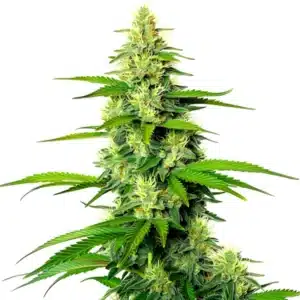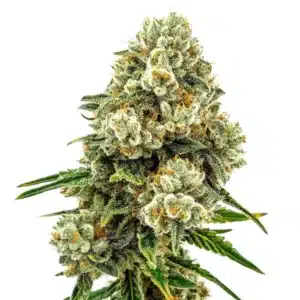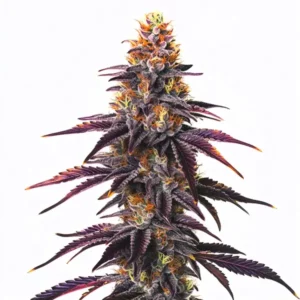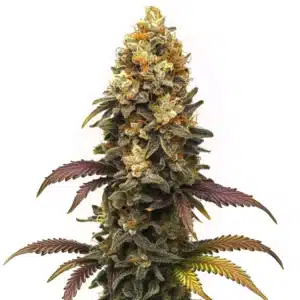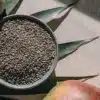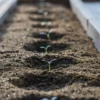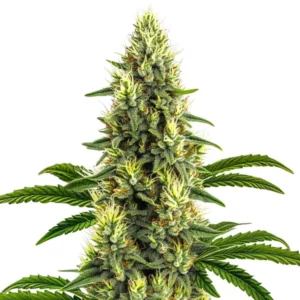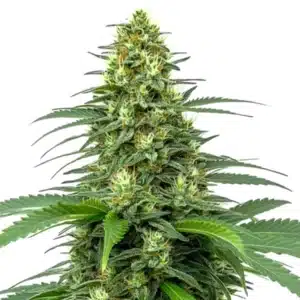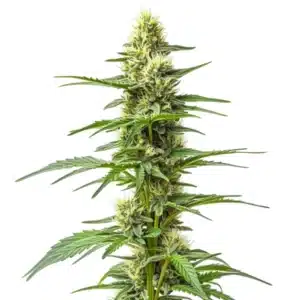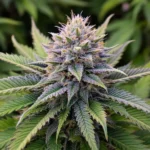
How to Grow White Widow x California Snow Autoflower
Strain Description
White Widow x California Snow Auto is a sophisticated hybrid blending the legendary resinous White Widow, the uplifting Californian Snow, and hardy ruderalis genetics to create a vigorous, fast-finishing plant. With a mostly-Sativa profile (55% Sativa / 45% Indica), it delivers medium THC levels of 15%–18% and very low CBD (0.02%), making it perfect for those seeking an energetic, euphoric buzz paired with gentle body relaxation. The buds develop a signature frosty coating of trichomes and emit a bright citrus-sweet aroma underscored by earthy and woody undertones, reflecting its diverse genetic heritage.
One of its most attractive features is the autoflowering trait inherited from ruderalis, which bypasses photoperiod requirements and completes its full cycle from germination to harvest in just 8–10 weeks. Plants remain compact, topping out at around 3.94 ft (1.2 m), making them suitable for small tents, balconies, or discreet outdoor gardens. Yields are modest compared to photoperiod strains approximately 0.98 oz/ft² (300 g/m²) indoors but can reach up to 19 oz (550 g) per plant outdoors under ideal conditions. Medicinal users often turn to this strain for relief from arthritis, insomnia, and chronic pain, thanks to its terpene profile featuring alpha-terpineol, beta-caryophyllene, gamma-terpinene, humulene, myrcene, and limonene, which together provide anti-inflammatory, analgesic, and sedative effects without excessive sedation.
Recommended Strains
White Widow x California Snow Auto
|
|
THC | 15% - 18% (Medium) |
|
|
Type | Autoflowering |
|
|
Yield | Low |
|
|
Phenotype | 45% Indica / 55% Sativa |
Auto White Widow CBD
|
|
CBD | 10% – 12% (Medium) |
|
|
Type | CBD Autoflowering |
|
|
Yield | Low |
|
|
Phenotype | 40% Indica / 60% Sativa |
Promos & Deals
Growing Environment
Successful cultivation of White Widow x California Snow Autoflower hinges on creating a stable, well-ventilated environment that supports vigorous growth and robust resin production. Indoors, aim to maintain daytime temperatures between 70–78 °F (21–26 °C), with a slight nighttime drop to 65–70 °F (18–21 °C). These moderate temperature swings mimic natural conditions and encourage optimal metabolic function. Relative humidity should stay around 50–60% during the early vegetative phase to support healthy transpiration and reduce stress. Once flowering begins around week 4 gradually lower humidity to 40–50% to prevent powdery mildew and bud rot, two common issues in dense Sativa-leaning colas.
Lighting is a crucial factor: although autoflowers don’t require a change in light schedule, providing a consistent 18 hours of light and 6 hours of darkness maximizes photosynthesis without triggering stress. High-quality full-spectrum LEDs are ideal for their efficiency, low heat output, and tailored spectrum that supports both vegetative growth and resinous flowering. HPS or CMH lamps also work but require careful temperature monitoring. Outdoors, select a location that receives at least 6–8 hours of direct sunlight daily. Soil should be fertile and well-draining; amend native earth with compost, perlite, or worm castings to boost structure and nutrient content. Shelter the plants from strong winds with simple windbreaks wooden stakes draped with shade cloth and ensure good airflow to reduce the risk of fungal issues.
Setting Up Your Grow Space
White Widow x California Snow Autoflower Indoor Cultivation
For indoor grows, choose a grow tent or dedicated room lined with reflective Mylar to maximize light efficiency. Install an exhaust fan paired with a carbon filter to manage temperature, humidity, and odors. Position oscillating fans at canopy height to maintain gentle air movement, which strengthens stems and helps prevent hot spots. Fill 1-gallon starter pots with a high-quality organic soil mix ideally pH-buffered between 6.0 and 6.5. After 3 weeks or when plants show 3–4 nodes, transplant into 3–5 gallon containers to allow the root system to expand and support heavier buds later in flower.
Autoflowers like White Widow x California Snow do not rely on photoperiod shifts; they will begin flowering according to age. Maintain an 18/6 light schedule from seed to finish. Consider staggering your sowings every 2–3 weeks to establish a rolling harvest system. Label each batch with its start date and monitor individually to optimize space usage and prevent harvest overlap. Keep environmental monitors (hygrometer, thermometer, CO₂ sensor) within the canopy to track conditions in real time and make adjustments as needed. Proper environment control can boost resin gland density by up to 20% under ideal LED lighting and CO₂ enrichment strategies.
White Widow x California Snow Autoflower Outdoor Cultivation
Outdoors, plant your autoflower seeds directly into raised beds or large fabric pots (5–10 gallon) filled with amended soil. Prepare the planting site by mixing native soil with aged compost, perlite, and worm castings at a ratio of 2:1:1 to improve drainage and fertility. Space plants at least 2–3 ft apart to allow for airflow and canopy expansion. Water deeply when the top inch of soil dries, then allow a slight dry-down between sessions to encourage root depth and resilience to heat stress.
Mulch heavily around the base of each plant with straw or wood chips to retain moisture, regulate soil temperature, and suppress weeds. Install low windbreaks using stakes and permeable netting to protect fragile autoflower stems without creating a stagnant microclimate. Companion plant with pest-repellent herbs such as basil, marigold, or lavender to attract beneficial predatory insects (ladybugs, lacewings) and reduce the need for chemical interventions. Outdoor autoflowers thrive in all-season climates but perform best when nighttime lows stay above 50 °F (10 °C) and daytime highs remain below 85 °F (29 °C).

Germination
Begin the lifecycle by germinating your feminized autoflower seeds. Soak seeds in distilled water for 12–24 hours to soften the seed coat and improve germination rates. Transfer to a damp paper towel placed inside a resealable plastic bag or container, then store in a warm spot (75–80 °F / 24–27 °C) with 70–80% humidity. Check daily; once taproots emerge (typically 24–72 hours), carefully transfer each to a pre-moistened seedling pot filled with a light, well-draining mix. Plant seeds root-down about ¼ inch below the surface, gently firming soil to maintain seed-to-soil contact.
Place seedlings under gentle CFL or low-power LED lights at approximately 24 inches distance, providing 18 hours of light and 6 hours of darkness. Avoid direct intense light until true leaves form. Maintain soil moisture at around 60% keep the mix damp but never waterlogged. Strong germination and seedling establishment set the stage for robust vegetative growth and higher final yields.
White Widow x California Snow Autoflower Vegetative Phase
The vegetative phase for an autoflower like White Widow x California Snow typically spans weeks 2–4 from germination. During this stage, provide 18 hours of bright, full-spectrum light daily. Feed a balanced NPK fertilizer with a slight emphasis on nitrogen (e.g., 3-1-2 NPK) at 50% of the manufacturer’s recommended strength to encourage healthy leaf and stem development. Increase feeding strength gradually to 75% by the end of week 3, monitoring plants for signs of nutrient burn (leaf tip browning) or deficiency (yellowing lower leaves).
Implement low-stress training (LST) early after the third node to bend and secure branches horizontally, creating an even canopy that maximizes light penetration and bud site exposure. Use soft plant ties and move ties daily to guide growth without breaking stems. Maintain environmental conditions at 72–76 °F (22–24 °C) and relative humidity around 50–60%. Water when the top inch of soil dries, ensuring deep root growth and preventing overwatering issues. Well-trained and properly nourished autoflowers often yield 10–20% more than untrained controls.
White Widow x California Snow Autoflower Flowering Phase
Flowering is automatically triggered in autoflowers around week 4, regardless of light schedule. Transition to a bloom nutrient formula higher in phosphorus and potassium (e.g., 1-3-2 NPK) at 75% strength to support flower development. Maintain temperature between 68–75 °F (20–24 °C) and reduce humidity to 40–50% to inhibit mold and promote resin production. Increase airflow with oscillating fans and ensure exhaust systems efficiently remove stale air.
As buds swell, support heavy colas with bamboo stakes or a simple trellis netting system to prevent branch breakage. Continue LST if desired to fill canopy gaps. Monitor trichome development with a 30x loupe plan harvest when approximately 70–80% of trichomes turn milky-white with 10–20% turning amber for the ideal balance of THC potency and flavor. Autoflowering strains often finish faster, so timely nutrient adjustments and environmental control are critical during this condensed bloom cycle.
Fertilization and Nutrition
Autoflowers thrive on consistent, moderate feeding. Veg Phase (weeks 2–3): 50% strength of vegetative nutrient (3-1-2 NPK) with added beneficial microbes such as mycorrhizae to boost root health. Early Flower (week 4): maintain 75% veg nutrient until buds are visible. Mid to Late Flower (weeks 5–8): switch to bloom formula (1-3-2 NPK) at 75–100% strength, depending on plant response. Use organic supplements like kelp or compost tea weekly to feed soil microbiology and enhance terpene expression.
Flush with plain, pH-balanced water during the final week before harvest to remove excess salts, improve smoke smoothness, and preserve terpenes. Keep runoff pH between 6.0–6.5 throughout to ensure optimal nutrient availability and prevent lockouts.
Pest and Disease Control
Autoflowers have a shorter cycle, which reduces long-term pest pressure, but regular monitoring is still essential. Inspect leaves particularly the undersides daily for spider mites, aphids, or thrips. Keep the grow area clean: remove fallen leaves and sanitize tools between uses. Apply neem oil or insecticidal soap as a preventive measure every 10 days, avoiding application during peak light hours to prevent leaf burn.
At the first sign of powdery mildew or botrytis, prune the affected areas immediately, increase ventilation, and apply an organic antifungal spray (e.g., 1:9 milk-to-water solution). Early intervention saves yields and maintains bud quality.
White Widow x California Snow Autoflower Harvesting and Curing
Harvest White Widow x California Snow Autoflower when 70–80% of trichomes are cloudy with 10–20% amber. Use clean, sharp shears to cut branches at the base. Hang whole branches upside down in a dark, well-ventilated room at 60–65 °F (15–18 °C) and 50–60% humidity. Drying takes 7–10 days branches should snap rather than bend when fully dry.
Trim buds from the branches and place them in airtight jars with 62% relative humidity packs. “Burp” jars for 10–15 minutes daily during the first week to release excess moisture, then every 2–3 days for the next 2–3 weeks. Proper curing unlocks the full flavor profile, smooths the smoke, and preserves the cannabinoid and terpene content for long-term storage.
Is White Widow x California Snow Autoflower Indica or Sativa?
White Widow x California Snow Autoflower leans slightly Sativa (55% Sativa / 45% Indica). Expect a clear cerebral uplift creativity, energy, and sociability balanced by a gentle body relaxation that soothes aches without heavy sedation. This makes it suitable for daytime or evening social activities.
Advantages and Disadvantages
Advantages:
- Rapid 8–10 week cycle from seed to harvest.
- No light schedule changes required 18/6 works throughout.
- Compact growth (under 4 ft) suits small spaces and stealth grows.
- Energetic, euphoric high with mild body relaxation.
- Effective for arthritis, insomnia, and mild pain relief.
Disadvantages:
- Low yields compared to photoperiod strains (0.98 oz/ft² indoors).
- Heavy colas require early support to prevent breakage.
- Sensitive to overwatering and nutrient imbalances.
- Short cycle leaves little room for error in feeding or environment.
Why Buy This Strain
White Widow x California Snow Autoflower is ideal for growers seeking a quick, straightforward cycle paired with a motivating, creative high. Feminized autoflower seeds remove guesswork every seed becomes a flowering plant without the need to identify males. Its compact size makes it perfect for small indoor tents, balconies, or discreet outdoor spots. The strain’s balanced euphoric and relaxing effects, combined with therapeutic benefits for arthritis and pain, offer both recreational enjoyment and medicinal relief.
Its easy-going nature makes it a stellar choice for beginners: no complex light schedules, forgiving genetics that tolerate minor mistakes, and consistent performance across multiple grow cycles. For seasoned cultivators, it offers an opportunity for rapid turnover and staggered harvests through successive sowings every 2–3 weeks.
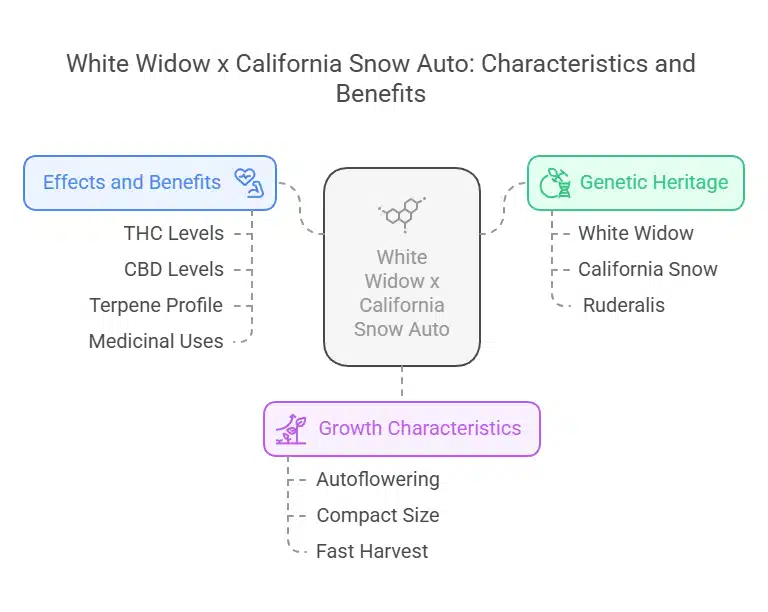
Similar Strains
White Widow Auto
White Widow Auto retains the legendary resin production and balanced effects of the original photoperiod variety but finishes in 8–9 weeks from seed. Indoor yields range from 300–350 g/m² under strong LEDs, and outdoor plants yield 4–6 oz each. Its balanced head and body high, along with dense, frosty buds, make it a natural cousin to White Widow x California Snow AF.
Amnesia Haze Auto
Amnesia Haze Auto brings the classic haze flavor and potency into an autoflowering package. Finishing in 10 weeks, it yields around 200–250 g/m² indoors and 4–6 oz per plant outdoors. Its potent, clear-headed buzz and citrusy aroma align with the uplifting Sativa traits of White Widow x California Snow AF, making it another go-to for creative daytime use.
White Fire Alien Kush
White Fire Alien Kush (a.k.a. WiFi Alien Kush) is a potent hybrid that fuses the frosty intensity of White Fire OG (WiFi OG) with the exotic, hashy richness of Alien Kush. This strain offers elevated THC levels, powerful cerebral effects, and a complex terpene profile that blends citrus, pine, diesel, and subtle earthy spice.
Super Glue Strain Seeds
Super Glue is a high-potency hybrid strain that merges the knockout body effects of Afghani with the cerebral, pungent profile of Northern Lights.
Pro Tips for Professionals
- Staggered Sowing: Sow a new batch every 2–3 weeks to maintain a rolling harvest. Label each pot with sow date and track performance metrics.
- CO₂ Enrichment: Introduce a small CO₂ bag or controlled tank during bloom to boost resin gland density and yields by up to 20% under strong LED lighting.
- Low-Stress Training: Start LST in week 2 to spread the canopy, increase light penetration, and improve airflow crucial in a short auto cycle.
- Precision Nutrient Management: Keep EC and pH within tight ranges (EC 0.8–1.2, pH 6.0–6.5). Use automated dosing systems if available for consistency.
- Integrated Pest Management: Combine sticky traps, beneficial insects (predatory mites), and organic biopesticides. Inspect weekly and intervene early at the first signs of infestation.
- Data Logging: Record temperature, humidity, and feeding schedules daily. Analyze trends to refine protocols and troubleshoot issues rapidly.
FAQs
How tall will White Widow x California Snow Autoflower grow?
Plants typically reach around 3.94 ft (1.2 m) without training. Using LST and topping early can keep height under 3.5 ft, ideal for small tents or discreet outdoor grows.
Can beginners successfully grow this strain?
Yes feminized autoflower seeds eliminate the need to sex plants, and the 18/6 light schedule simplifies lighting. Focus on consistent watering, moderate feeding, and gentle training to achieve a healthy harvest.
What yield can I expect indoors vs. outdoors?
Indoors, anticipate about 300 g/m² under strong LEDs and optimal conditions. Outdoors, in a warm, sunny climate with good soil, you can achieve up to 550 g per plant.


